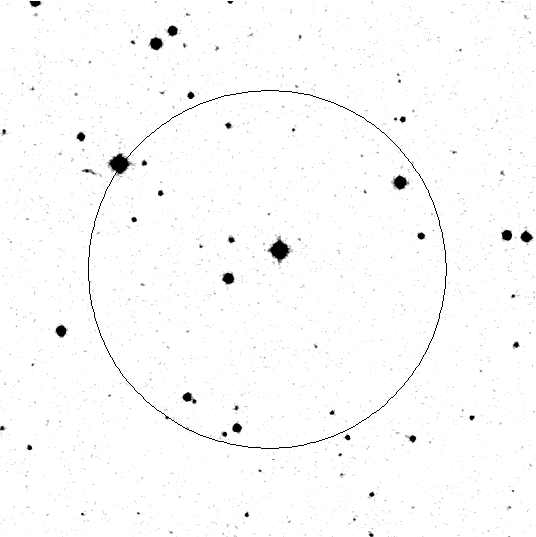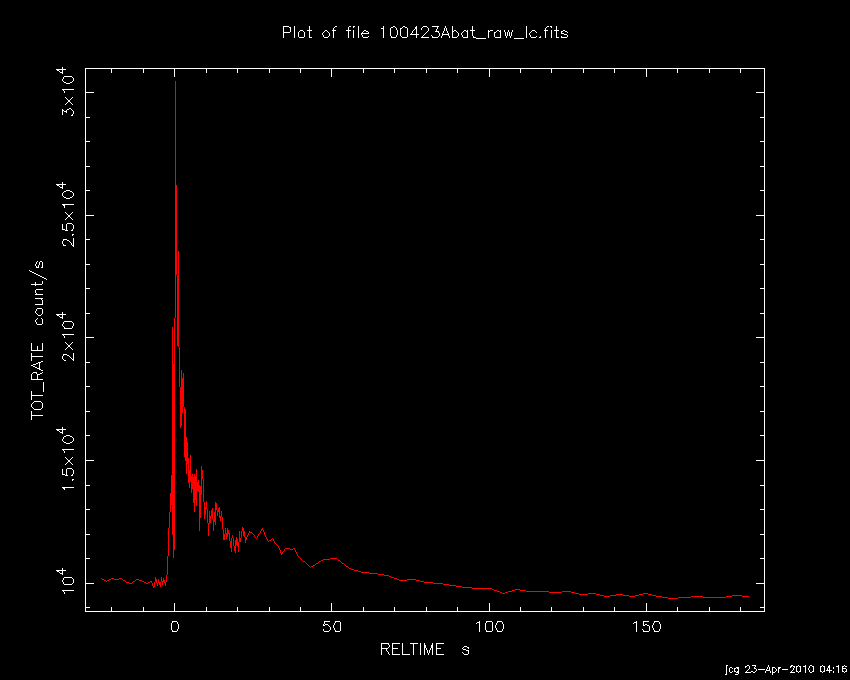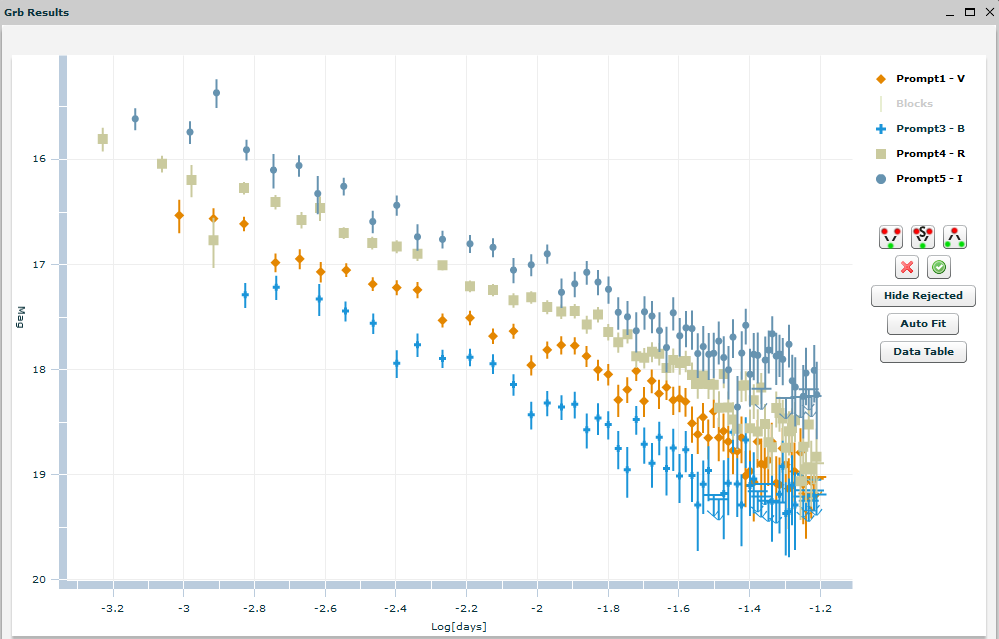- GCN/BACODINE POSITION NOTICE
TITLE: GCN/SWIFT NOTICE
NOTICE_DATE: Fri 23 Apr 10 00:35:22 UT
NOTICE_TYPE: Swift-BAT GRB Position
TRIGGER_NUM: 420247, Seg_Num: 0
GRB_RA: 136.477d {+09h 05m 54s} (J2000),
136.625d {+09h 06m 30s} (current),
135.760d {+09h 03m 02s} (1950)
GRB_DEC: +21.479d {+21d 28' 46"} (J2000),
+21.438d {+21d 26' 16"} (current),
+21.680d {+21d 40' 48"} (1950)
GRB_ERROR: 3.00 [arcmin radius, statistical only]
GRB_INTEN: 15361 [cnts] Image_Peak=1406 [image_cnts]
TRIGGER_DUR: 1.024 [sec]
TRIGGER_INDEX: 155 E_range: 50-350 keV
BKG_INTEN: 45965 [cnts]
BKG_TIME: 2082.26 SOD {00:34:42.26} UT
BKG_DUR: 8 [sec]
GRB_DATE: 15309 TJD; 113 DOY; 10/04/23
GRB_TIME: 2099.16 SOD {00:34:59.16} UT
GRB_PHI: 179.49 [deg]
GRB_THETA: 32.26 [deg]
SOLN_STATUS: 0x3
RATE_SIGNIF: 116.22 [sigma]
IMAGE_SIGNIF: 21.49 [sigma]
MERIT_PARAMS: +1 +0 +0 +0 +3 +7 -5 +0 +17 +0
SUN_POSTN: 30.56d {+02h 02m 15s} +12.43d {+12d 25' 51"}
SUN_DIST: 99.95 [deg] Sun_angle= -7.1 [hr] (East of Sun)
MOON_POSTN: 140.91d {+09h 23m 38s} +12.19d {+12d 11' 08"}
MOON_DIST: 10.12 [deg]
MOON_ILLUM: 65 [%]
GAL_COORDS: 206.24, 38.72 [deg] galactic lon,lat of the burst (or transient)
ECL_COORDS: 132.61, 4.65 [deg] ecliptic lon,lat of the burst (or transient)
COMMENTS: SWIFT-BAT GRB Coordinates.
COMMENTS: This is a rate trigger.
COMMENTS: A point_source was found.
COMMENTS: This does not match any source in the on-board catalog.
COMMENTS: This does not match any source in the ground catalog.
COMMENTS: This is a GRB.
COMMENTS: This trigger occurred at longitude,latitude = 352.83,-6.98 [deg].
- red DSS finding chart
ps-file

- GCN NOTICE
TITLE: GCN/SWIFT NOTICE
NOTICE_DATE: Fri 23 Apr 10 00:38:49 UT
NOTICE_TYPE: Swift-BAT GRB Lightcurve
TRIGGER_NUM: 420247, Seg_Num: 0
GRB_RA: 136.477d {+09h 05m 54s} (J2000),
136.625d {+09h 06m 30s} (current),
135.760d {+09h 03m 02s} (1950)
GRB_DEC: +21.479d {+21d 28' 46"} (J2000),
+21.438d {+21d 26' 16"} (current),
+21.680d {+21d 40' 48"} (1950)
GRB_DATE: 15309 TJD; 113 DOY; 10/04/23
GRB_TIME: 2099.16 SOD {00:34:59.16} UT
TRIGGER_INDEX: 155
GRB_PHI: 179.49 [deg]
GRB_THETA: 32.26 [deg]
DELTA_TIME: 71.00 [sec]
TRIGGER_DUR: 1.024 [sec]
SOLN_STATUS: 0x3
RATE_SIGNIF: 116.22 [sigma]
IMAGE_SIGNIF: 21.49 [sigma]
LC_URL: sw00420247000msb.lc
SUN_POSTN: 30.56d {+02h 02m 15s} +12.43d {+12d 25' 53"}
SUN_DIST: 99.95 [deg] Sun_angle= -7.1 [hr] (East of Sun)
MOON_POSTN: 140.94d {+09h 23m 46s} +12.17d {+12d 10' 22"}
MOON_DIST: 10.14 [deg]
MOON_ILLUM: 65 [%]
GAL_COORDS: 206.24, 38.72 [deg] galactic lon,lat of the burst (or transient)
ECL_COORDS: 132.61, 4.65 [deg] ecliptic lon,lat of the burst (or transient)
COMMENTS: SWIFT-BAT GRB Lightcurve.
COMMENTS:
COMMENTS: The next comments were copied from the BAT_POS Notice:
COMMENTS: This is a rate trigger.
COMMENTS: A point_source was found.
COMMENTS: This does not match any source in the on-board catalog.
COMMENTS: This does not match any source in the ground catalog.
COMMENTS: This is a GRB.
COMMENTS: This trigger occurred at longitude,latitude = 352.83,-6.98 [deg].

- GCN Circular #10651
M. C. Stroh (PSU), P. A. Evans (U Leicester), J. M. Gelbord (PSU),
S. T. Holland (CRESST/USRA/GSFC), J. A. Kennea (PSU),
C. B. Markwardt (CRESST/GSFC/UMD), D. M. Palmer (LANL),
M. H. Siegel (PSU), M. A. Stark (PSU) and L. Vetere (PSU) report on
behalf of the Swift Team:
At 00:34:59 UT, the Swift Burst Alert Telescope (BAT) triggered and
located GRB 100423A (trigger=420247). Swift could not slew to
this source because it was too close to the Moon (~10 degrees).
The BAT on-board calculated location is
RA, Dec 136.477, +21.479 which is
RA(J2000) = 09h 05m 54s
Dec(J2000) = +21d 28' 46"
with an uncertainty of 3 arcmin (radius, 90% containment, including
systematic uncertainty). The BAT light curve showed single peak
FRED with a duration of at least 100 sec, and a brief precursor spike
at T-0.5. The peak count rate was ~21000 counts/sec (15-350 keV),
at ~0 sec after the trigger.
Due to a Moon constraint, Swift could not slew to observe this
source with the XRT and UVOT. The source will become observable
early on April 24 UT.
Burst Advocate for this burst is M. C. Stroh (stroh AT astroh.org).
Please contact the BA by email if you require additional information
regarding Swift followup of this burst. In extremely urgent cases, after
trying the Burst Advocate, you can contact the Swift PI by phone (see
Swift TOO web site for information: http://www.swift.psu.edu/too.html.)
- GCN Circular #10652
Robert Filgas, Jochen Greiner (both MPE) and Adria Updike (Clemson Univ.)
report on behalf of the GROND team:
We observed the field of GRB 100423A (Swift trigger 420247; Stroh et al.,
GCN 10651) simultaneously in g'r'i'z'JHK with GROND (Greiner et al. 2008,
PASP 120, 405) mounted at the 2.2 m MPI/ESO telescope at La Silla Observatory
(Chile). Observations started at 00:37 UT on April 23, 2010, 150 sec after the
Swift trigger. They were performed at an average seeing of 1" and at airmass
of 1.8, respectively.
We found a single variable point source within the 3' error circle, not
visible in either 2MASS or DSS2 at
RA (J2000.0) = 09h 05m 50.22s
Dec (J2000.0) = +21d 29' 54.3"
with an uncertainty of 0.3" in each coordinate. From the first 4 min
observation we estimate the following preliminary magnitudes
g = 17.7+-0.1
r = 17.6+-0.1
i = 17.5+-0.1
z = 17.4+-0.1
J = 17.3+-0.1
H = 16.9+-0.1
K = 16.5+-0.1
calibrated against SDSS and 2MASS, and not corrected for the expected
foreground extinction of E(B-V)=0.04 (Schlegel et al. 1998).
The object faded by 0.3 mag between the first and second 4 min observation,
and thus is likely the GRB afterglow.
Since the object is seen in all GROND bands, the redshift is smaller than
about 3.5. We encourage spectroscopic observations.
- GCN Circular #10653
K. Ivarsen, D. Reichart, J. Haislip, A. LaCluyze, R. Egger, A. Foster, J.
Moore, A. Oza, M. Schubel, A. Trotter, J. A. Crain, and M. Nysewander
report:
Skynet observed the Swift/BAT localization of GRB 100423A (Stroh et al.,
GCN 10651) with four of the 16" PROMPT telescopes at CTIO beginning 49
seconds after the trigger in BVRI.
We detect the afterglow (Filgas et al., GCN 10652) in all filters.
At 51 seconds after the trigger, its magnitude is R = 15.81 +0.12 -0.11
(calibrated to 13 SDSS stars, transformed using Jester et al., 2005, ApJ,
130, 873.)
Until about 8 minutes after the trigger, the afterglow faded with a
power-law index of about -0.5. Afterward, it steepened. Between 30 and 90
minutes after the trigger, the afterglow faded with a power-law index of
about -1.1.
Skynet's most recent BVRI light curve, calibrated to SDSS stars, can be
found here:
http://skynet.unc.edu/grb/grb100423a.png

- GCN Circular #10658
J. R. Cummings (GSFC/UMBC), S. D. Barthelmy (GSFC), W. H. Baumgartner (GSFC/UMBC),
N. Gehrels (GSFC), H. A. Krimm (GSFC/USRA), C. B. Markwardt (GSFC/UMD),
D. M. Palmer (LANL), T. Sakamoto (GSFC/UMBC), M. Stamatikos (GSFC/ORAU),
M. C. Stroh (PSU), J. Tueller (GSFC), T. N. Ukwatta (GWU)
(i.e. the Swift-BAT team):
Using the data set from T-61 to T+242 sec from the recent telemetry downlink,
we report further analysis of BAT GRB 100423A (trigger #420247)
(Stroh, et al., GCN Circ. 10651). The BAT ground-calculated position is
RA, Dec = 136.471, 21.487 deg, which is
RA(J2000) = 09h 05m 53.0s
Dec(J2000) = +21d 29' 13.4"
with an uncertainty of 1.0 arcmin, (radius, sys+stat, 90% containment).
The partial coding was 74%.
The mask-weighted light curve shows a couple small peaks starting at ~T-4 sec,
then a large peak at T_zero and peaking at ~T+0.1 sec, and then a long roughly
exponential decay out to T+160 where the burst went out of the BAT FOV
due a slew to avoid an observing constraint. We cannot quote a T90,
because there was still burst emission when it went out of the FOV.
The time-averaged spectrum from T-12.9 to T+99.1 sec is best fit by a simple
power-law model. The power law index of the time-averaged spectrum is
1.07 +- 0.05. The fluence in the 15-150 keV band is 8.5 +- 0.2 x 10^-6 erg/cm2.
The 1-sec peak photon flux measured from T+10.60 sec in the 15-150 keV band
is 1.2 +- 0.2 ph/cm2/sec. All the quoted errors are at the 90% confidence
level.
The results of the batgrbproduct analysis are available at
http://gcn.gsfc.nasa.gov/notices_s/420247/BA/
- GCN Circular #10678
D. Kuroda, K. Yanagisawa, Y. Shimizu, H. Toda (OAO, NAOJ),
S. Nagayama (NAOJ), M. Yoshida (Hiroshima), K. Ohta (Kyoto)
and N. Kawai(Tokyo Tech)
report on behalf of the MITSuME collaboration:
We observed the field of GRB 100423A (Stroh et al. GCNC 10651)
with the optical three color (g', Rc and Ic) CCD camera attached
to the MITSuME 50cm telescope of Okayama Astrophysical Observatory.
The observation started on 2010-04-23 13:27:35 UT (~12.9h after the
burst). We could not detect the previously reported afterglow
(Filgas et al., GCN 10652) in all the three bands.
Three sigma upper limits of the OT are listed below. We used SDSS
catalog for flux calibration.
T0+[day] MID-UT T-EXP[sec] g' Rc Ic
------------------------------------------------------
0.59033 14:45:04 4500.0 >18.9 >19.0 >18.4
------------------------------------------------------
T0+ : Elapsed time after the burst [day]
T-EXP: Total Exposure time [sec]
- GCN Circular #10695
V. Rumyantsev, D. Shakhovskoy (CrAO), A. Volnova (SAI MSU), A.
Pozanenko (IKI) report on behalf of larger GRB follow-up
collaboration:
We observed the field of the Swift GRB 100423A (Stroh et al., GCN
10651) with AZT-11 telescope of CrAO Observatory between (UT) Apr. 23
18:15 - 18:46. We do not detect source at the position of the
afterglow (Filgas et al., GCN 10652; Ivarsen et al., GCN 10653).
The upper limit of the stacked image based on USNO-B1.0 star
1115-0180143 (RA(J2000) = 09 05 44.73 Dec(J2000)= +21 31 14.0) and
assuming R=17.21 is following:
T0+ Filter, Exposure, mag.
(mid, d) (s)
0.7489 R 11x180 >20.7
The upper limit is compatible with power-law decay index -1.1 reported
by Ivarsen et al. (GCN 10653).
- GCN Circular #10696
S. Golenetskii, R.Aptekar, D. Frederiks, E. Mazets, V. Pal'shin,
P. Oleynik, M. Ulanov, D. Svinkin, and T. Cline on behalf
of the Konus-Wind team, report:
The long GRB 100423A (Swift-BAT trigger=420247;
Stroh et al., GCN 10651; Cummings et al., GCN 10658)
triggered Konus-Wind at T0=02097.629s UT (00:34:57.629)
The burst light curve started with a hard short (~150 ms)
precursor followed (after ~0.6 s) by a FRED-like pulse
with a total duration of ~100 s.
The Konus-Wind light curve of this GRB is available at
http://www.ioffe.ru/LEA/GRBs/GRB100423_T02097/
As observed by Konus-Wind the burst
had a fluence of 4.8(+/-0.5)x10-5 erg/cm2,
and a 256-ms peak flux measured from T0+0.768s
of 8.3(+/-0.6)x10-6 erg/cm2/s
(both in the 20 keV - 2 MeV energy range).
The time-integrated spectrum of the burst
(from T0 to T0+65.792 s) is best fit
in the 20 keV - 2 MeV range by the GRB (Band)
model, for which:
the low-energy photon index alpha = -0.71 (-/+0.25),
the high energy photon index beta = -2.15 ( <-1.9 ),
the peak energy Ep = 455(-83, +194)keV (chi2 = 96/57 dof).
The spectrum at the maximum count rate
(measured from T0+0.256 to T0+8.848 s) is best fit
in the 20 keV - 2 MeV range by a power law
with exponential cutoff model, for which
alpha = -0.50(+/-0.15),
and Ep = 621(-67, +82) keV (chi2 = 74/58 dof).
All the quoted results are preliminary.
All the quoted errors are at the 90% confidence level.
- GCN Circular #10705
L.P. Xin, Z.X. Lin, Y.L. Qiu, J.Y. Wei,J. Wang, J.S. Deng,
C. Wu, J.Y. Hu, on behalf of EAFON report:
We began to observe GRB100423A (Stroh et al., GCN 10651;
Filgas et al., GCN 10652; Ivarsen et al., GCN 10653)
with Xinglong TNT telescope at 14:33:45(UT). The moon
light was very bright. A series of R band images was
obtained. No new source was found in the XRT errorbars
within the combined 6*300s R band image. The 3 sigma upper
limit is about 19.5 mag derived from USNO-B1.0,at the mean
time of 14.2 hour after the burst.
This message may be cited.
For more information about Xinglong GRBs Follow-up
observations, please visit the website:
http://www.xinglong-naoc.org/grb/
- GCN Circular #10709
N. Vasquez (Tokyo Tech.), K. Yamaoka (Aoyama Gakuin U.), S. Sugita (Nagoya U),
T. Uehara, Y. Hanabata, T. Takahashi, Y. Fukazawa (Hiroshima U.),
Y. Terada, M. Tashiro, S. Hong, A. Endo, K. Onda, T. Sugasahara, W. Iwakiri
(Saitama U.), M. Ohno, M. Kokubun, T. Takahashi (ISAS/JAXA),
Y. E. Nakagawa, M. Suzuki, T. Tamagawa (RIKEN), N. Ohmori, A. Daikyuji,
E. Sonoda, K. Kono, H. Hayashi, K. Noda, Y. Nishioka, M. Yamauchi
(Univ. of Miyazaki), Y. Urata, H. M. Lin, P. Tsai
(NCU), T. Enoto, K. Nakazawa, K. Makishima (Univ. of Tokyo),
on behalf of the Suzaku WAM team, report:
The bright long, SWIFT GRB 100423A (TRIGGER_NUM:420247),
GNC 10651 (M. C. Stroh et. al.), Konus-Wind GCN10696 ( S. Golenetskii et. al.)
triggered the Suzaku Wide-band All-sky Monitor (WAM) which covers an
energy range
of 50 keV - 5 MeV at 00:34:57.78 UT (=T0).
The observed light curve shows a single peak FRED T0-1 s,
ending at T0+69 s with a duration (T90) of about 54 seconds.
The fluence in 100 - 1000 keV was 3.71(-0.22, +0.11)x10-5 erg/cm^2.
The 1-s peak flux measured from T0+1.5 s was 7.31(-0.35, +0.35)
photons/cm^2/s in the same energy range.
Preliminary result shows that the time-averaged spectrum from
T0-1 s to T0+69 s is well fitted by a GRB Band model as follows.
the low-energy photon index alpha: -0.43(-0.27, +0.31),
the high-energy photon index beta: -3.82(-1.33, +6.18),
and the peak energy Epeak: 649.8(-44.5, +44.5) keV (chi^2/d.o.f = 31/27).
All the errors are quoted at 90% confidence level.
The light curves for this burst are available at:
http://www.astro.isas.ac.jp/suzaku/HXD-WAM/WAM-GRB/grb/trig/1500.html
![]() Previous IAU Circulars
Previous IAU Circulars 

